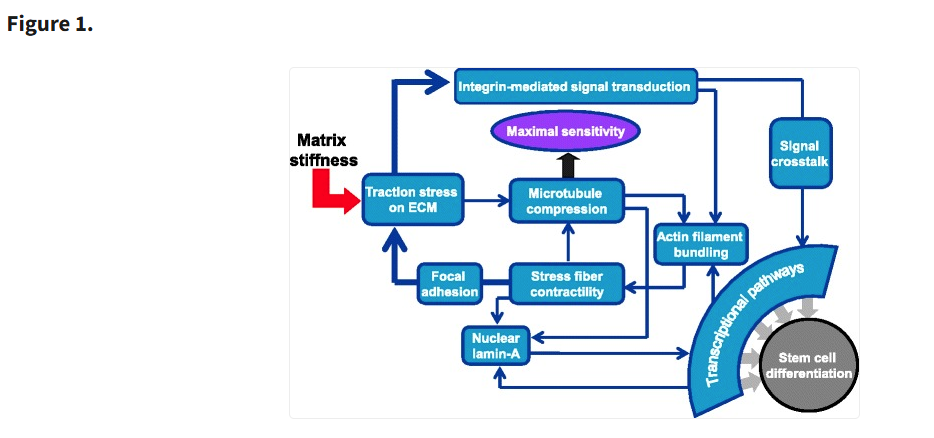Flexcell International Corp, Burlington, NC
Osteoarthritis (OA) affects over 500 million people worldwide, yet treatment remains largely palliative focused on pain relief rather than prevention or repair. Recent research is unlocking the mechanobiology of joint health, revealing how cells in our joints sense and respond to mechanical forces.
There were over 47 studies published in 2024 pointing the way toward a more advanced OA in vitro model that does not just replicate disease but helps us understand and possibly reverse it. In order to create a realistic OA model, take these molecular manifestations into consideration in your in vitro experiments:
Piezo1: The Master Switch of Mechanical Sensation
Piezo1 is a mechanosensitive ion channel that responds to physical forces—like joint loading during walking or running. Recent studies (Lei et al., Feng et al.) show that overactivation of Piezo1 contributes to cartilage degradation, especially in temporomandibular joint osteoarthritis (TMJOA). In a mouse model with jaw misalignment, increased Piezo1 activity led to cartilage breakdown, while inhibiting Piezo1 helped preserve the extracellular matrix. Piezo1 is not just a passive responder, but a driver of cartilage degeneration under mechanical stress. In any meaningful OA model, Piezo1 activity should be monitored and modulated.
PDZK1: The Mitochondrial Guardian Against Overload
While Piezo1 can cause damage under excessive stress, PDZK1 plays defense. PDZK1 is a mitochondrial regulator that protects chondrocytes (the cells in cartilage) from damage induced by mechanical overload. According to Shao et al., PDZK1 deficiency leads to oxidative stress, mitochondrial dysfunction, and accelerated cartilage aging. Restoring PDZK1 or treating with mitochondrial antioxidants like MitoQ reversed these effects. Mechanical stress is a double-edged sword. While some load is good, overload without proper mitochondrial support leads to OA. A robust OA model must include mitochondrial health metrics and perhaps test therapies that preserve it.
Wnt/β-Catenin Pathway: Linking Bone Health and Cartilage Protection
Liu et al. revealed a compelling pathway that connects exercise to bone strength: mechanical strain downregulates Antxr1, which upregulates LncRNA H19 and activates the Wnt/β-catenin signaling pathway. The Wnt pathway is a key axis in both bone formation and cartilage maintenance. This discovery links mechanical cues to regenerative responses, showing how movement can help not just bones, but potentially slow or prevent cartilage degeneration. Any OA model must consider not only degeneration, but also the body's regenerative capacity under the right mechanical conditions.
Putting It All Together: A New Mechanobiology-Informed OA Model
Combining these findings, scientists can now design a next-gen osteoarthritis model that reflects the true complexity of the disease:
- Mechanical Loading: Apply cyclic tensile strain or shear stress to chondrocytes using Flexcell® Dynamic Bioreactor Systems.
- Piezo1 Monitoring: Measure and manipulate Piezo1 expression to mimic overload conditions or test inhibitors.
- PDZK1 Pathway: Include PDZK1-knockout cells or rescue with PDZK1/MitoQ to assess mitochondrial response.
- Wnt Axis Activation: Track Antxr1, LncRNA H19, and Wnt/β-catenin activity to study anabolic vs. catabolic responses.
Outcomes to Measure:
- ECM degradation (MMP13, aggrecan)
- Mitochondrial health (ROS, mtDNA, fusion/fission markers)
- Gene expression linked to regeneration and inflammation
- Histological scoring of cartilage integrity
By combining mechanical realism with molecular specificity, this new OA model allows researchers to:
- Understand why joints break down under stress
- Discover why exercise helps or hurts
- Test novel interventions targeting Piezo1, PDZK1, or the Wnt pathway
Using these OA models with mechanical loading is more than just a disease model. It is a platform for innovation that brings us closer to therapies that restore joint health from the inside out.

References:
Lei et al. Theranostics (2024)
Liu et al. Journal of Cellular Physiology (2024)
Shao et al. Bone Research (2024)
Feng et al. Oral Diseases (2024)



